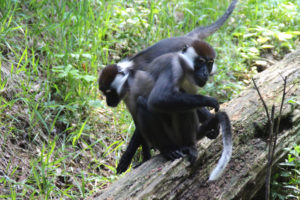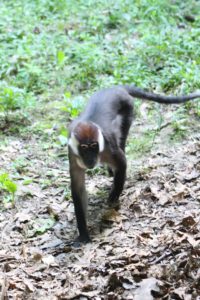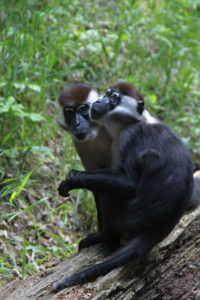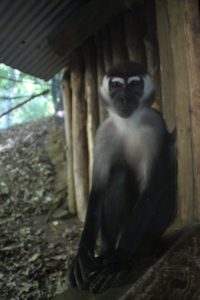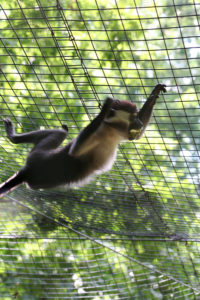RED-CAPPED MANGABEYCercocebus torquatus
Conservation Status: Endangered
Habitat loss

Learn More
Color:
Dorsal is dark gray; ventral is white; hair on crown is dark red; chin, cheeks, and sides of neck are white; face is black; white tip on tail
Size:
Male head and body 24”, tail 27.5"
Weight:
Male 20lb 5 oz; Female 12 lb 2 oz
Average Lifespan:
18 years
Captive Lifespan:
Up to 46 years
Tropical West Africa
Moist forest areas occurring in primary and secondary swamp, mangrove, and riverine forest.
Mating:
Polygamous; year-round; female has pronounced sexual swelling
Gestation/Incubation:
171 days
Litter/Clutch Size:
1
Mature:
5-7 years
Fruits, leaves, flowers, and animal prey
Diurnal and largely terrestrial. Multi-male groups or mixed groups of up to 10-35 individuals. Quadrupedal locomotion.
1. Communicate by draping tail over back. White tip on tail and white eyelids used in communication.
 Red-capped mangabeys are endangered primates native to the jungles of Nigeria. They have distinctive markings around their eyes and a variety of vocalizations for communicating with other troop members. Two females live at Binder Park Zoo, Lola and Kanzu. Lola and Kanzu enjoy training sessions with keeper staff. They are trained to present their hands and feet on cue, stand or climb up the mesh, and staff is working with them on injection training. All training is done by operant conditioning where the animal can choose to participate or not. Training is done for medical purposes to help us evaluate their health in a stress-free environment. Their favorite reward for training is fruit.
Red-capped mangabeys are endangered primates native to the jungles of Nigeria. They have distinctive markings around their eyes and a variety of vocalizations for communicating with other troop members. Two females live at Binder Park Zoo, Lola and Kanzu. Lola and Kanzu enjoy training sessions with keeper staff. They are trained to present their hands and feet on cue, stand or climb up the mesh, and staff is working with them on injection training. All training is done by operant conditioning where the animal can choose to participate or not. Training is done for medical purposes to help us evaluate their health in a stress-free environment. Their favorite reward for training is fruit.
Wild mangabeys spend much of their day foraging for food. Lola and Kanzu can be seen foraging in the leaves and grass for insects or food placed there by zookeeper staff - enrichment that promotes natural behaviors and keeps their minds stimulated. One of their favorite enrichment items are puzzle feeders that they must manipulate to receive the food contained within.


